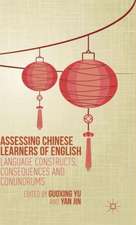Teaching & Researching: Language Learning Strategies: Applied Linguistics in Action
Autor Rebecca L. Oxforden Limba Engleză Paperback – 12 ian 2011
In demonstrating why self-regulated learning strategies are necessary for language proficiency, Oxford integrates socio-cultural, cognitive, and affective dimensions, and argues convincingly for the need for conceptual cross-fertilization. Providing clear and concise explanations of the advantages and limitations of the different approaches, this book is full of practical value and theoretical insights.
The book is designed to guide the reader with the use of a range of features, including:
- key quotes and concept boxes
- preview questions and chapter overviews
- glossary and end-of-chapter further readings
- sources and resources section
| Toate formatele și edițiile | Preț | Express |
|---|---|---|
| Paperback (1) | 365.66 lei 6-8 săpt. | |
| Taylor & Francis – 12 ian 2011 | 365.66 lei 6-8 săpt. | |
| Hardback (1) | 1000.27 lei 6-8 săpt. | |
| Taylor & Francis – 8 oct 2015 | 1000.27 lei 6-8 săpt. |
Preț: 365.66 lei
Nou
Puncte Express: 548
Preț estimativ în valută:
69.97€ • 73.05$ • 57.91£
69.97€ • 73.05$ • 57.91£
Carte tipărită la comandă
Livrare economică 04-18 aprilie
Preluare comenzi: 021 569.72.76
Specificații
ISBN-13: 9780582381292
ISBN-10: 0582381290
Pagini: 360
Dimensiuni: 156 x 234 x 20 mm
Greutate: 0.67 kg
Ediția:1
Editura: Taylor & Francis
Colecția Routledge
Seria Applied Linguistics in Action
Locul publicării:Oxford, United Kingdom
ISBN-10: 0582381290
Pagini: 360
Dimensiuni: 156 x 234 x 20 mm
Greutate: 0.67 kg
Ediția:1
Editura: Taylor & Francis
Colecția Routledge
Seria Applied Linguistics in Action
Locul publicării:Oxford, United Kingdom
Cuprins
Table of Contents
Foreword
Part I: The Strategic Self-Regulation (S2R) Model of language learning
Chapter 1 Introducing the Strategic Self-Regulation (S2R) Model of language learning
1.1Overview
1.2 The S2R Model
1.3 Conclusion
Further Reading
Chapter 2 Dimension 1 (cognitive): Strategies for remembering and processing language
2.1 Linked metaphors for metacognitive strategies and cognitive strategies
2.2 Metacognitive knowledge, metacognitive strategies and metacognition
2.3 Cognitive strategies
2.4 Relevant theories and concepts
2.5 Conclusion
Further Reading
Chapter 3 Dimension 2 (affective): Strategies for emotions, beliefs, attitudes and motivation
3.1 Linked metaphors for meta-affective and affective strategies
3.2 Meta-affective knowledge, meta-affective strategies, and meta-affect
3.3 Affective strategies
3.4 Relevant theories and concepts
3.5 Conclusion
Further Reading
Chapter 4 Dimension 3 (sociocultural-interactive): Strategies for contexts, communication and culture
4.1 Linked metaphors of meta-SI strategies and SI strategies
4.2 Meta-SI knowledge, meta-SI strategies and the ‘meta’ level sociocultural-interaction
4.3 SI strategies
4.4 Relevant theories and concepts
4.5 Conclusion
Further Reading
Part II: Authentic Uses of Strategy Assessment and Strategy Assistance
Chapter 5 Strategy assessment in the S2R Model
5.1 Purposes of strategy assesssment
5.2 Key issues at the outset
5.3 Strategy observations
5.4 Actual-task verbal reports
5.5 Colour-coding of actual-task strategies
5.6 Learner portfolios that include task-related strategy assessment
5.7 Individual interviews for strategy assessment
5.8 Group interviews and discussions for strategy assessment
5.9 Discourse analysis for strategy assessment
5.10 Strategy questionnaires
5.11 Narratives for strategy assessment
5.12 Quality of strategy assessment tools
5.13 Conclusion
Further Reading
Chapter 6 Strategy instruction and other types of strategy assistance in the S2R Model
6.1 Key terms
6.2 Culture as a factor in excellent strategy assistance
6.3 Strategy instruction in separate learning-to-learn courses or programmes
6.4 Direct strategy instruction integrated into regular L2 courses
6.5 Integrating strategy instruction into L2 textbooks and course materials
6.6 The learning consultation service model
6.7 Strategy instruction through learner guidebooks
6.8 Strategy instruction in distance learning
6.9 Conclusion
Further Reading
Part III: Researching Learning Strategies
Chapter 7 A guide to conducting research on self-regulated L2 learning strategies
7.1 Worldviews underlying various research methods
7.2 Overview of methods for research
7.3 Quantitative research methods, models and validity
7.4 Qualitative research methods, models and validity
7.5 Mixed methods
7.6 Action research
7.7 General cautions in thinking about validity
7.8 Reminders about research quality and utility regardless of method
7.9 Ethics in L2 learning strategy research
7.10 Conclusion
Further Reading
Chapter 8 What we know from L2 learning strategy research
8.1 L2 reading strategies
8.2 L2 writing strategies
8.3 L2 listening strategies
8.4 L2 speaking strategies
8.5 L2 vocabulary learning strategies
8.6 L2 grammar learning strategies
8.7 Comparisons across L2 areas
8.8 Findings across more general strategy studies
8.9 Conclusion
Further Reading
Part IV: Exploring Further
Chapter 9 Strategic ‘intellectual geography’ and resources for further exploration
9.1 Part 1 of the geography lesson: review of landmarks of the S2R Model
9.2 Part 2 of the geography lesson: the terrain of self-regulated L2 learning strategies
9.3 Resources
9.4 Strengthening relationships while expanding strategy research and instruction
9.5 Conclusion
Further Reading
Notă biografică
Rebecca L. Oxford is Professor Emerita, University of Maryland. She is the author of Language Learning Strategies: What Every Teacher Should Know (1990) and edited Language Learning Strategies: Cross-Cultural Perspectives (1996). She is currently working as Professor of Language Education and Research for the U.S. Air Force Culture and Language Center.
Recenzii
"Presents a relatively compact, well-resourced, and authoritative guide to the learning strategies field."
- ELT Journal
- ELT Journal
Descriere
New to the regarded Applied Linguistics in Action series, this accessible and informative book redraws the language learning strategy landscape. In this book Rebecca Oxford offers practical, innovative suggestions for assessing, teaching, and researching language learning strategies, she provides examples of strategies and tactics from all levels, from beginners to distinguished-level learners, as well as a new taxonomy of strategies for language learning.








































